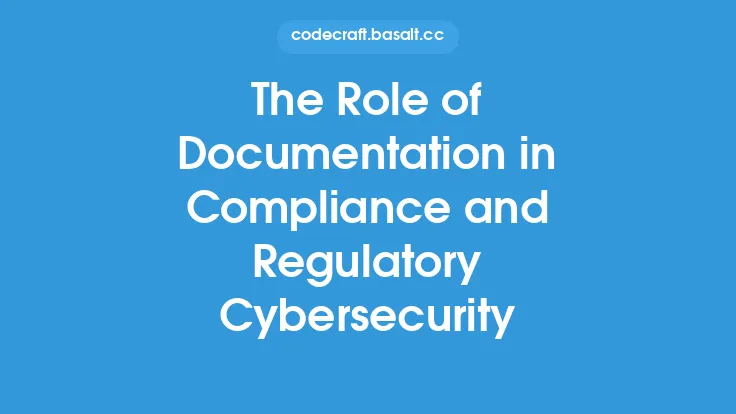In the realm of cybersecurity, maintaining a robust and transparent record of all system activities is crucial for ensuring compliance with regulatory requirements and industry standards. This is where audit trails come into play, serving as a chronological record of all system events, including user interactions, data modifications, and system changes. The importance of audit trails in compliance and regulatory cybersecurity cannot be overstated, as they provide a clear and tamper-evident record of all system activities, enabling organizations to demonstrate their adherence to regulatory requirements and industry standards.
What are Audit Trails?
Audit trails are a type of logging mechanism that captures all system events, including user logins, data access, modifications, and system changes. They provide a detailed record of all system activities, including the date, time, user ID, and description of each event. Audit trails can be generated by various system components, including operating systems, applications, and network devices. They are typically stored in a secure and tamper-evident manner, such as in a database or a log file, to prevent unauthorized modifications or deletions.
Benefits of Audit Trails in Compliance and Regulatory Cybersecurity
Audit trails offer several benefits in compliance and regulatory cybersecurity, including:
- Demonstrating compliance: Audit trails provide a clear and transparent record of all system activities, enabling organizations to demonstrate their adherence to regulatory requirements and industry standards.
- Detecting and responding to security incidents: Audit trails can help organizations detect and respond to security incidents, such as unauthorized access or data breaches, by providing a detailed record of all system events leading up to and during the incident.
- Conducting forensic analysis: Audit trails can be used to conduct forensic analysis of security incidents, helping organizations to identify the root cause of the incident and take corrective action to prevent similar incidents in the future.
- Identifying and addressing vulnerabilities: Audit trails can help organizations identify and address vulnerabilities in their systems and applications, reducing the risk of security incidents and data breaches.
Key Components of an Effective Audit Trail
An effective audit trail should have several key components, including:
- Timestamps: Each event should be timestamped to provide a clear and accurate record of when the event occurred.
- User ID: Each event should be associated with a unique user ID to identify the user responsible for the event.
- Event description: Each event should have a detailed description of what occurred, including any relevant data or system changes.
- System information: Each event should include information about the system or application involved, including the IP address, hostname, and software version.
- Data integrity: Audit trails should be stored in a secure and tamper-evident manner to prevent unauthorized modifications or deletions.
Technical Considerations for Implementing Audit Trails
Implementing audit trails requires careful consideration of several technical factors, including:
- Log collection and storage: Organizations should have a centralized log collection and storage system to collect and store audit trails from various system components.
- Log analysis and monitoring: Organizations should have a log analysis and monitoring system to analyze and monitor audit trails in real-time, detecting and responding to security incidents.
- Data retention and archiving: Organizations should have a data retention and archiving policy to ensure that audit trails are retained for a sufficient period to meet regulatory requirements and industry standards.
- Security and access controls: Organizations should have robust security and access controls in place to prevent unauthorized access to audit trails and ensure that they are handled and stored in a secure and tamper-evident manner.
Best Practices for Implementing Audit Trails
To implement effective audit trails, organizations should follow several best practices, including:
- Develop a comprehensive logging strategy: Organizations should develop a comprehensive logging strategy that includes all system components and events.
- Use standardized logging formats: Organizations should use standardized logging formats, such as syslog or JSON, to facilitate log collection and analysis.
- Implement log rotation and retention: Organizations should implement log rotation and retention policies to ensure that audit trails are retained for a sufficient period.
- Monitor and analyze logs in real-time: Organizations should monitor and analyze logs in real-time to detect and respond to security incidents.
Common Challenges and Limitations of Audit Trails
While audit trails are a crucial component of compliance and regulatory cybersecurity, they are not without challenges and limitations. Common challenges and limitations include:
- Log volume and complexity: Large volumes of log data can be complex and difficult to analyze, making it challenging to detect and respond to security incidents.
- Log quality and accuracy: Poor log quality and accuracy can make it difficult to rely on audit trails for compliance and regulatory purposes.
- Storage and retention: Storing and retaining large volumes of log data can be costly and require significant storage and infrastructure resources.
- Security and access controls: Ensuring the security and integrity of audit trails can be challenging, particularly in environments with multiple users and systems.
Conclusion
In conclusion, audit trails are a critical component of compliance and regulatory cybersecurity, providing a clear and transparent record of all system activities. By understanding the benefits, key components, and technical considerations of audit trails, organizations can implement effective audit trails that demonstrate compliance with regulatory requirements and industry standards. By following best practices and addressing common challenges and limitations, organizations can ensure that their audit trails are reliable, accurate, and effective in detecting and responding to security incidents.





